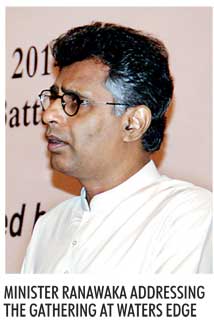.jpg)
.jpg)
 t a time when the Sri Lanka’s Central Bank (CB) is setting the stage to by-pass a potential economic stagnation and become a ‘break-out nation’, a senior government minister yesterday said that country is gradually being ensnared in the middle income trap.
t a time when the Sri Lanka’s Central Bank (CB) is setting the stage to by-pass a potential economic stagnation and become a ‘break-out nation’, a senior government minister yesterday said that country is gradually being ensnared in the middle income trap.
Minister of Technology and Research Patali Champika Ranawaka noted that Sri Lanka had entered into the middle income territory as way back as in 1998 and is still trapped inside this bracket.
This is despite claims by the country’s official economic institutions that the country is making steady progress to avoid such stagnation.
“Evaluation of these factors from an economic perspective reveals that the country is gradually being ensnared in what is known as the middle-income trap,” Minister Ranawaka said delivering the key note address at the 7th biennial conference on science and technology, yesterday.
According to economists, trapped economies face dual challenges in exporting; they become unable to compete against both low income and low wage economies and highly skilled and innovative advanced economies.
(1)(86).jpg)
This is despite claims by the country’s official economic institutions that the country is making steady progress to avoid such stagnation
(1)(86).jpg)
This is because once a country reaches the middle income category its income levels are higher so that they cannot compete with new entrants such as Vietnam, Cambodia and Bangladesh because they cannot effectively compete with these low-waged poor countries.
On the other hand, a middle income country cannot break-out to become a rich nation because of no innovation in such countries in comparison with rich countries and also due to the reason that their previously unemployed population is now employed and could only be lured for high-tech production at significantly higher wages.
According to the World Bank Atlas for 2010, a country is a poor country if its per capita income is US $ 1,005 or less. A country is a lower middle income country if its per capita income is between US $ 1,006 and US $ 3,975 and a higher middle income country if it is between US $ 3,976 and US $ 12,275. A country is rich if the per capital income is above US $12,276.
(1)(86).jpg)
According to the Central Bank annual report, Sri Lanka’s per capita income has increased from US $ 2,922 in 2012 to US $ 3,280 in 2013
(1)(86).jpg)
According to the Central Bank annual report, Sri Lanka’s per capita income has increased from US $ 2,922 in 2012 to US $ 3,280 in 2013.
Central Bank aspires to reach US $ 4,000 per capita income by 2016 and become a break-out nation.
Last year the World Bank and the Economists Intelligence Unit warned Sri Lanka that the country faces a high risk of moving from the current level of income to a middle income level - meaning that the country was poised to get entangled in a lower middle income trap before it faces the eventual middle income trap properly.
“The mere increase in per capita GDP is not something that we can be content with. Striving for a mere increase of per capita GDP could well lead to social unrest and destabilization and the eventual collapse of social capital,” the minister noted.
.jpg)
.jpg)
 t a time when the Sri Lanka’s Central Bank (CB) is setting the stage to by-pass a potential economic stagnation and become a ‘break-out nation’, a senior government minister yesterday said that country is gradually being ensnared in the middle income trap.
t a time when the Sri Lanka’s Central Bank (CB) is setting the stage to by-pass a potential economic stagnation and become a ‘break-out nation’, a senior government minister yesterday said that country is gradually being ensnared in the middle income trap.(1)(86).jpg)
(1)(86).jpg)
(1)(86).jpg)
(1)(86).jpg)